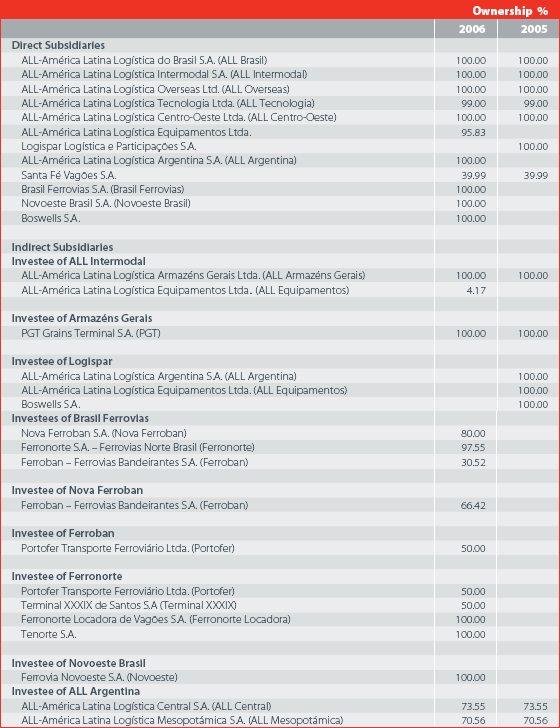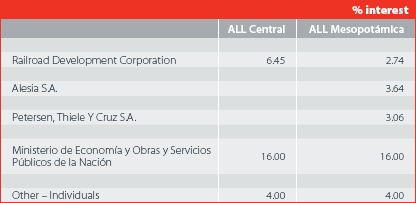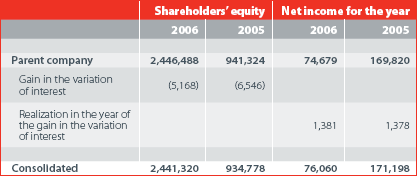 |


(a) Overall aspects
The financial statements were prepared and are presented in conformity with the accounting practices adopted in Brazil, considering the accounting guidelines set forth in the corporation law and in the rules of the Securities and Exchange Commission of Brazil - CVM.
The authorization for the conclusion of the preparation of these financial statements occurred at the meeting of the board of executive officers held on February 16, 2007. The preparation of the financial statements requires the Management to make estimates based on assumptions that affect the values of assets, liabilities, revenues, expenses and disclosures presented in the financial statements. Material items subject to these estimates and assumptions include the selection of the useful life of the fixed assets and their recoverability in operations, credit risk analysis to determine the allowance for doubtful accounts, as well as the analysis of other risks to determine other provisions, including provision for contingencies and assessment of financial instruments and other assets and liabilities on the balance sheet date.
As a result of the settlement of transactions comprising these estimates, values may be materially different from those recorded in the financial statements due to inaccuracies inherent to the estimate process. The Company reviews its estimates and assumptions at least quarterly.
Assets and liabilities are classified as current when its realization or settlement is probable to take place in the next twelve months. Otherwise, they are stated as non-current. Monetary foreign currency denominated assets and liabilities were translated into reais according to the balance exchange rate. Differences resulting from the translation of currency were recognized in the statement of income. For subsidiaries located abroad, its assets, liabilities and income ended on December 31, 2006 were translated into reais according to the exchange rate on the balance sheet closing date, R$0.699839 to P$1.00 (Argentine peso) (on December 31, 2005 - R$0.773785 to P$1.00) to Companies headquartered in Argentina and R$2.138 to US$1.00 (U.S. dollar) (on December 31, 2005 – R$2.3407 to US$1.00). Exchange gains (losses) of foreign currency denominated investments are recorded in the result under the item financial income (expenses).
(b) Consolidated financial statements
The consolidated financial statements comprise the Company’s operations and the following subsidiaries’ operations, the percentage ownership of which on the balance sheet date is summarized as follows:

ALL Central and ALL Argentina have the following minority interest breakdown on December 31, 2006:

The fiscal years of the subsidiaries included in the consolidated are coincident with the parent company’s and the accounting practices evenly applied in the consolidated companies and consistent with those used in the previous year.
ALL Argentina negotiated with its minority shareholder Railroad Development Corporation the acquisition of its interest of 6.45% and 2.74% of ALL Central and ALL Mesopotámica. The trading depends on the approval of the share transfer by the Argentine government.
For Companies ALL Argentina (direct subsidiary), ALL Central (indirect subsidiary), ALL Mesopotámica (indirect subsidiary), headquartered in Argentina and Boswells S.A. (direct subsidiary), headquartered in Uruguay, analyses were carried out with a view to adapting the accounting principles adopted in Argentina and Uruguay to the accounting principles adopted in Brazil. Except for the indirect subsidiaries ALL Central and ALL Mesopotámica, which amortize the organization expenditures and pre-operating costs under the item deferred permanent assets for periods which differ from the criteria used in the balance sheets in compliance with Brazilian rules, no other differences in accounting practices were identified.
Besides the investments in Santa Fé Vagões S.A. and Terminal XXXIX, whose controls are shared with other shareholders, assets, liabilities and results are consolidated proportionally to the interest in the Capital Stock of those investees. For the subsidiaries, direct and indirect ones, their total assets, liabilities and results were consolidated, highlighting, when applicable, the interest of minority shareholders in shareholders’ equity and in the result of the periods. Investments in subsidiaries, non-realized profits and the portion correspondent to its shareholders’ equity were eliminated in the consolidation, as well as asset and liability balances, revenues and expenses resulting from transactions realized among consolidated companies, as indicated in Notes 12 and 19.
The financial statements of indirect subsidiaries based on Argentina, used for consolidation purposes, consider as a whole the inflationary effects of such country up to August 31, 1995 and from January 1, 2002 to February 28, 2003.
The conciliation of net income for the year and shareholders’ equity between the parent company and the consolidated is summarized as follows:

The gain of interest refers to the subscription and payment, on August 22, 2000, by ALL - América Latina Logística do Brasil S.A. of 16,573,431 shares of Itacaiúnas Participações S.A., with goodwill of R$21,193. Such subscription generated variation in the parent company’s interest from 100% to 63.03% of the capital with capital gain of R$13,782. The realization of this gain will take place as the locomotives, which originated the value of referred goodwill, are depreciated.
(c) Comparability of the financial statements
The comparison of the consolidated financial statements was significantly affected by the acquisition of investments in the subsidiaries Brasil Ferrovias S.A. and Novoeste Brasil S.A., as mentioned in Notes 1(a) and 12. The consolidated balance sheet of these companies drawn up on December 31, 2006 were consolidated, as well as the results of the operation related to the period from June 1 to December 31, 2006.
(d) Complementary information
As complementary information, the Company is also presenting the statements of cash flows. Such statements were prepared according to the rules established by IBRACON, Brazilian Institute of Independent Auditors and Accounting Federal Council, introduced in Note 30.
SUMMARY OF THE MAIN ACCOUNTING PRATICES
(a) Cash and cash equivalents
They include the balances in current account and redeemable financing investments in the term of 90 days of the balance sheet date, including, when applicable, income earned by the balance sheets dates.
(b) Allowance for doubtful accounts
The allowance for doubtful accounts is established in an amount considered sufficient by management to cover possible losses on the realization of credits, considering the client portfolio profile, the economic scenario and specific risks.
(c) Inventories
Inventory items are evaluated b y their average acquisition costs, which do not exceed the realization amounts.
(d) Lease and concessions (assets)
Lease and concession prepaid amounts are recorded at cost and allocated to result according to the remaining concession term.
(e) Investments
The significant investments in subsidiaries and affiliated companies were appraised by the equity method of accounting, adjusted to the recovery value when it is lower, as shown in Note 12; goodwill recorded upon the acquisition of subsidiaries based on expectation of future profitability is amortized on a straight-line basis over the remaining concession term based on the curve of future economic benefits generation.
(f) Fixed assets
Recorded at the acquisition, formation or construction cost (including interest and other financial charges linked to projects or constructions), whose depreciation is recognized on the straight-line basis, considering the estimated economic useful life of the assets at the annual rates described in Note 13.
(g) Intangible assets
Recorded at the acquisition and formation cost that do not overcome the realization values.
(h) Deferred charges
The portions of lease and concession cost, corresponding the pre-operating phase of Brazilian operations were deferred and have been amortized also over the concession term, as described in Note 14. The pre-operating and studies and projects expenditures are amortized within a five-year term, as from the occasion in which the benefits started to be generated.
(i) Determination of net income
Net income is determined by the accrual method. The revenues from services rendered are recorded as services are rendered. A revenue is not recognized if there is significant uncertainty of its realization.
(j) Advances for future capital increase
The Company records the amounts related to advances for future capital increase, received from participants of the Stock Option Plan described in Note 22, in shareholders’ equity account, considering the control and expectation that the Company has for resolution on conversion of advances in capital increase.
(k) Taxation
Charges (PIS, Cofins, ICMS and ISS) incurring on revenues from services rendered are presented as sales deductions in the statement of income. Credits deriving from the non-cumulativity of PIS/COFINS are presented deductively of the cost of services rendered in the statement of income.
Taxation on profit comprises the income tax and social contribution. The income tax is computed on the taxable income by the 15% rate, increased of a 10% additional for profits that exceed R$240 in the 12-month period, whereas the social contribution is computed by the 9% rate on the taxable income, recognized by the accrual method, therefore, inclusions to the accounting profit of expenses temporarily non-deductible, or revenue exclusions, temporarily non-taxable, for determination of the current taxable income generate deferred taxable credits or debits.
Certain subsidiaries record the provision for income tax awnd social contribution on net income, adopting the taxation regime by taxable income computed based on a percentage of gross sales or the taxation rules of the countries where these are located.
Prepayments or amounts subject to offset are stated in the current or non-current assets, according to the estimate of its realization.
Deferred tax credits arising from tax loss or negative basis of social contribution are stated by the amount expected to be realized. Some subsidiaries present a historic of recurring losses and, therefore, do not comply with criteria which rule the recognition of tax credits of such type, as per rules of the Securities and Exchange Commission, which will be recognized only when such conditions are fully reached. The recognized tax credit, as well as the basis of potential credits, not yet recognized in accounting statements, is disclosed in Note 10.